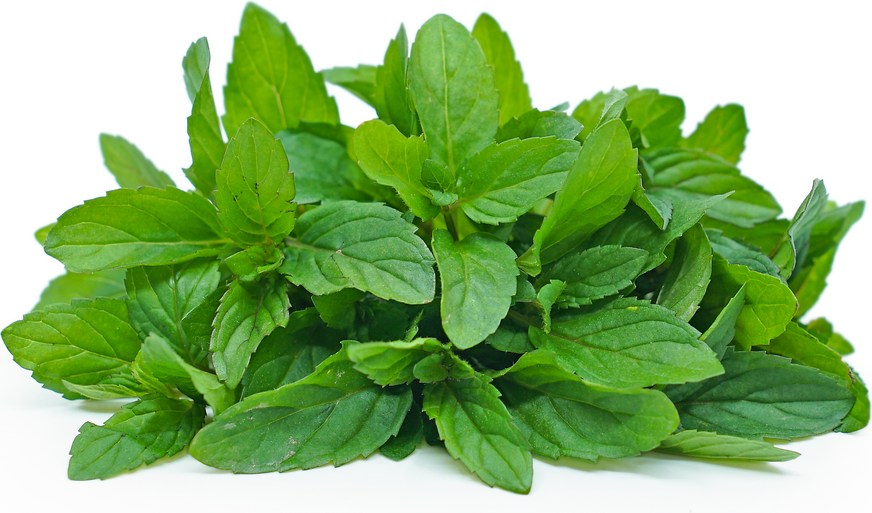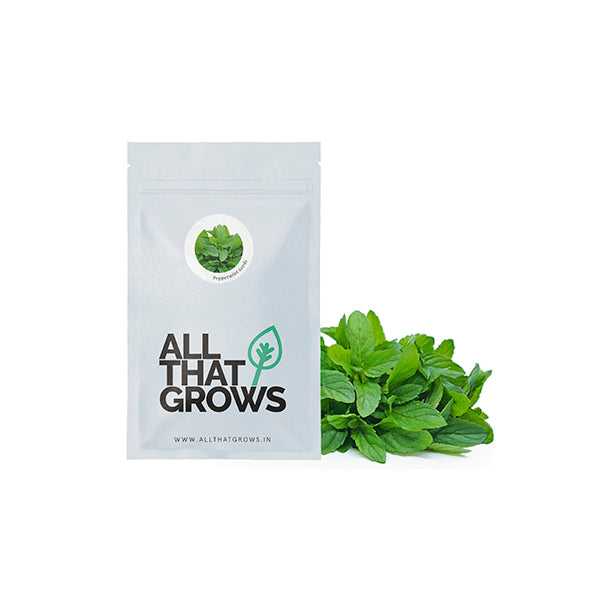



Peppermint Seeds
Grow this with
Seed Type: Non-hybrid, Open Pollinated & Non-GMO
Plant Character: Small white or purple flowers & plant grows to about 2 to 4 ft in height
Leaf Character: Dark Green Lanceolate fragrant leaf with 5 to 10 cm leaf blade
Cuttings: Prune old stalks and leaves to propagate new growth
Uses: Use fresh & dried peppermint leaves & stalk in tea, salad dressings, iced drinks, chocolates, tinctures & oils
- SOWING
TIMEFebruary To April
- Sowing
DistancePlant to Plant - 30 cms
- Fruit
WeightN/A
- Fruit
ShapeN/A
- Days to
maturity50 to 60 days
- Details
- How to sow
- Reviews
Peppermint, botanical name Mentha x Piperita L, is a flowering perennial herb first used in Egyptian & Greeks cultures for their inherent medicinal values. Peppermint herb is known to cure a common cold, cough, sinuses, digestive and menstrual issues. Peppermint also has a long history of varied unique uses as medicinal & cosmetic applications. The leaves of the plant can either be used fresh or dried while peppermint oil is popular amongst beauty industry. Peppermint plant grows to about 2 to 3 feet in height & produces small white or violet colored flowers. The foliage of the peppermint is dark green and highly fragrant. The leaves of the plant are harvested once the plant is fully grown and the leaves are most flavorsome. Peppermint leaf tea has become fairly common in tea culture around the world and is used to heal various ailments like spasms, biliary disorders & ingestion etc. Peppermint leaves and stalks can be harvested just prior to or during the flowering of the plant. The taste of peppermint is cool and minty and the sensory experience we get on eating peppermint is due to its menthol oils.
Planting instructions
Sow seeds indoors or directly sow outdoors in Feb - April. Seeds will germinate in about two weeks.
Sow the seeds about 1/4 inch deep in moist soil and water the cultivated area lightly till germination.
The potting soil must be damp but not over flooded with water. Since germination requires a rather warm temperature of about 22 to 25 °C(71 to 77°F), you can cover the seeding pot until germination and promote the growth with plenty of natural light afterwards.
Growing Requirements
Pests & Diseases
White flies, aphids, spider mites, and thrips are some of the common pests that can affect peppermint plant.
soil
Use well-drained & moist soil with pH ranging between 6 to 7.
Spot
Choose a sunny spot on your balcony or kitchen garden once the seeds have germinated. Peppermint can also tolerate mild shade. However, deep shade is not recommended.
temperature
Until germination, Peppermint plant thrives at a high temperature ranging between 22 to 25 °C(71 to 77°F) and after root development, the temperatures can be lowered to 19 to 24°C(65 to 75°F)
watering
All varieties of mint including peppermint prefer adequately moist growing medium. Watering frequency depends upon the surrounding growing conditions. For example, in case the seeds are sown in a dry area, watering every day is recommended. You can figure out the required watering frequency by checking the quality of potting soil.
how to harvest
Harvest peppermint leaves & stalks early morning when the flavorful oils are strongest.
While fresh peppermint leaves can add flavors and aromas to salads & other dishes
You can also dry peppermint leaves for peppermint tea.

Customer Reviews
The productiveness of any seed we sell is subject to your local climatic conditions*, the sowing method you adopt, and your commitment to the planting process. We give no warranty, expressed or implied, and are in no way responsible for the produce.
Please note that all our seasonal recommendations/ sowing information is as per the local climatic conditions. *For more information on the optimum conditions required for growing seeds in your region, please contact us at, hello@allthatgrows.in or Whatsapp us at, +91 8544865077
Questions & Answers
Have a Question?
Be the first to ask a question about this.




Peppermint Seeds
Seed Type: Non-hybrid, Open Pollinated & Non-GMO
Plant Character: Small white or purple flowers & plant grows to about 2 to 4 ft in height
Leaf Character: Dark Green Lanceolate fragrant leaf with 5 to 10 cm leaf blade
Cuttings: Prune old stalks and leaves to propagate new growth
Uses: Use fresh & dried peppermint leaves & stalk in tea, salad dressings, iced drinks, chocolates, tinctures & oils
Grow this with
Peppermint, botanical name Mentha x Piperita L, is a flowering perennial herb first used in Egyptian & Greeks cultures for their inherent medicinal values. Peppermint herb is known to cure a common cold, cough, sinuses, digestive and menstrual issues. Peppermint also has a long history of varied unique uses as medicinal & cosmetic applications. The leaves of the plant can either be used fresh or dried while peppermint oil is popular amongst beauty industry. Peppermint plant grows to about 2 to 3 feet in height & produces small white or violet colored flowers. The foliage of the peppermint is dark green and highly fragrant. The leaves of the plant are harvested once the plant is fully grown and the leaves are most flavorsome. Peppermint leaf tea has become fairly common in tea culture around the world and is used to heal various ailments like spasms, biliary disorders & ingestion etc. Peppermint leaves and stalks can be harvested just prior to or during the flowering of the plant. The taste of peppermint is cool and minty and the sensory experience we get on eating peppermint is due to its menthol oils.
Seed Type: Non-hybrid, Open Pollinated & Non-GMO
Plant Character: Small white or purple flowers & plant grows to about 2 to 4 ft in height
Leaf Character: Dark Green Lanceolate fragrant leaf with 5 to 10 cm leaf blade
Cuttings: Prune old stalks and leaves to propagate new growth
Uses: Use fresh & dried peppermint leaves & stalk in tea, salad dressings, iced drinks, chocolates, tinctures & oils
- SOWING
TIMEFebruary To April
- Sowing
DistancePlant to Plant - 30 cms
- Fruit
WeightN/A
- Fruit
ShapeN/A
- Days to
maturity50 to 60 days
Planting instructions
Sow seeds indoors or directly sow outdoors in Feb - April. Seeds will germinate in about two weeks.
Sow the seeds about 1/4 inch deep in moist soil and water the cultivated area lightly till germination.
The potting soil must be damp but not over flooded with water. Since germination requires a rather warm temperature of about 22 to 25 °C(71 to 77°F), you can cover the seeding pot until germination and promote the growth with plenty of natural light afterwards.
Growing Requirements
Pests & Diseases
White flies, aphids, spider mites, and thrips are some of the common pests that can affect peppermint plant.
soil
Use well-drained & moist soil with pH ranging between 6 to 7.
Spot
Choose a sunny spot on your balcony or kitchen garden once the seeds have germinated. Peppermint can also tolerate mild shade. However, deep shade is not recommended.
temperature
Until germination, Peppermint plant thrives at a high temperature ranging between 22 to 25 °C(71 to 77°F) and after root development, the temperatures can be lowered to 19 to 24°C(65 to 75°F)
watering
All varieties of mint including peppermint prefer adequately moist growing medium. Watering frequency depends upon the surrounding growing conditions. For example, in case the seeds are sown in a dry area, watering every day is recommended. You can figure out the required watering frequency by checking the quality of potting soil.
how to harvest
Harvest peppermint leaves & stalks early morning when the flavorful oils are strongest.
While fresh peppermint leaves can add flavors and aromas to salads & other dishes
You can also dry peppermint leaves for peppermint tea.



 Sign In
Sign In








